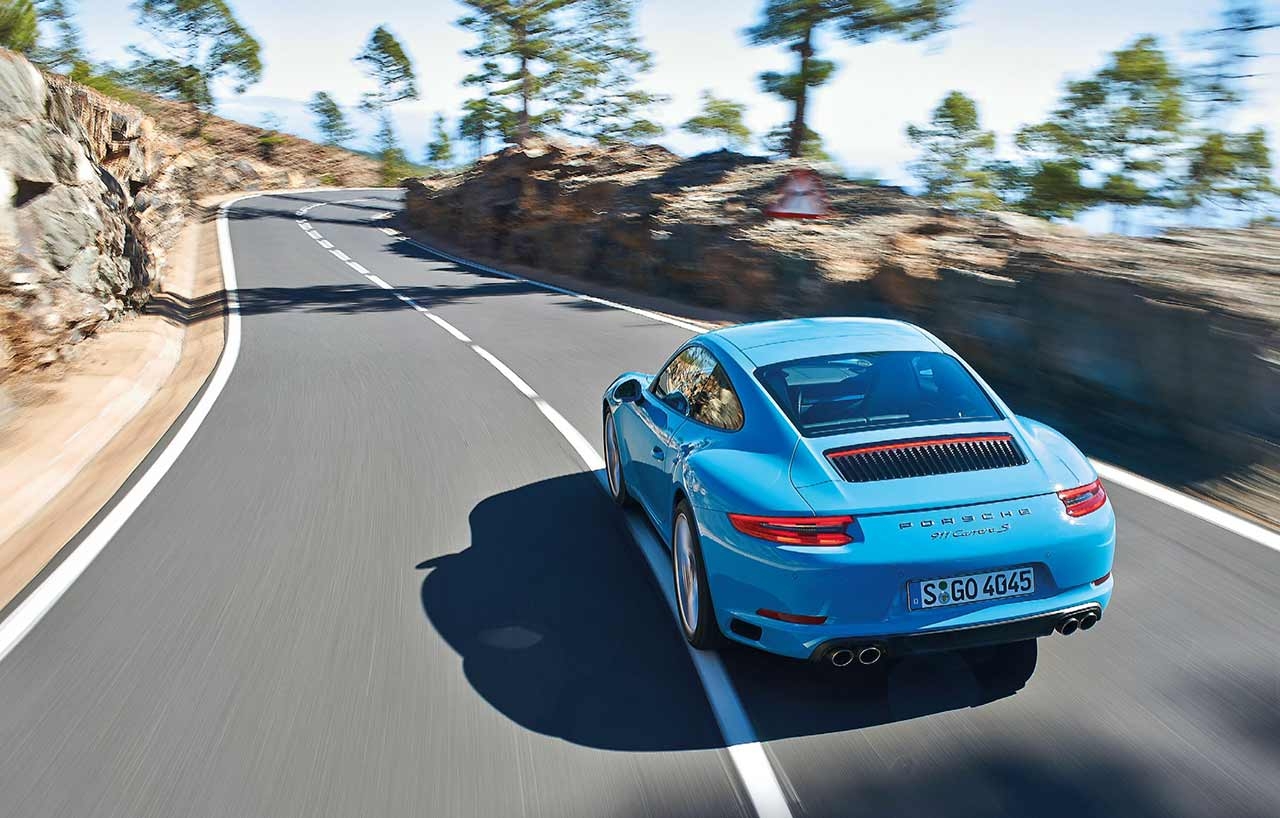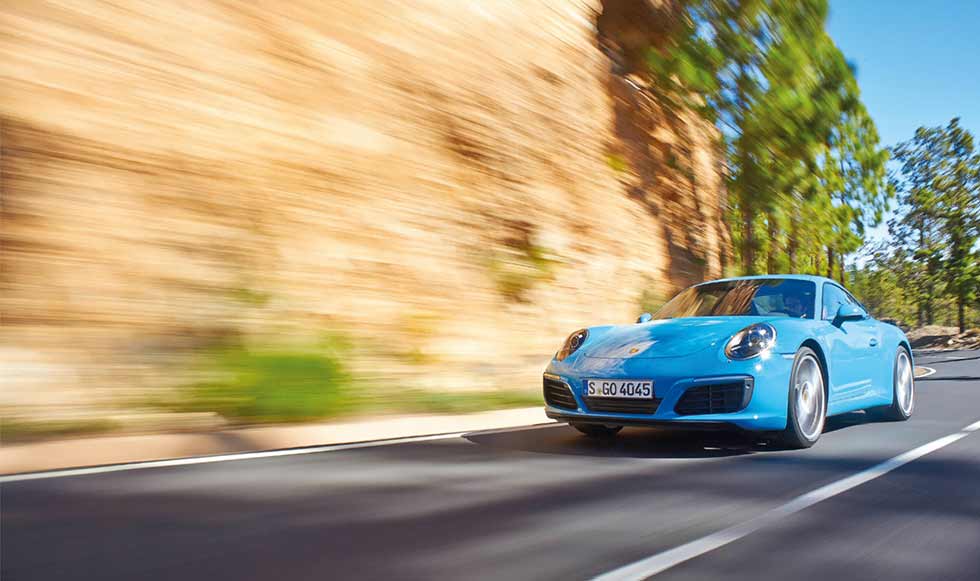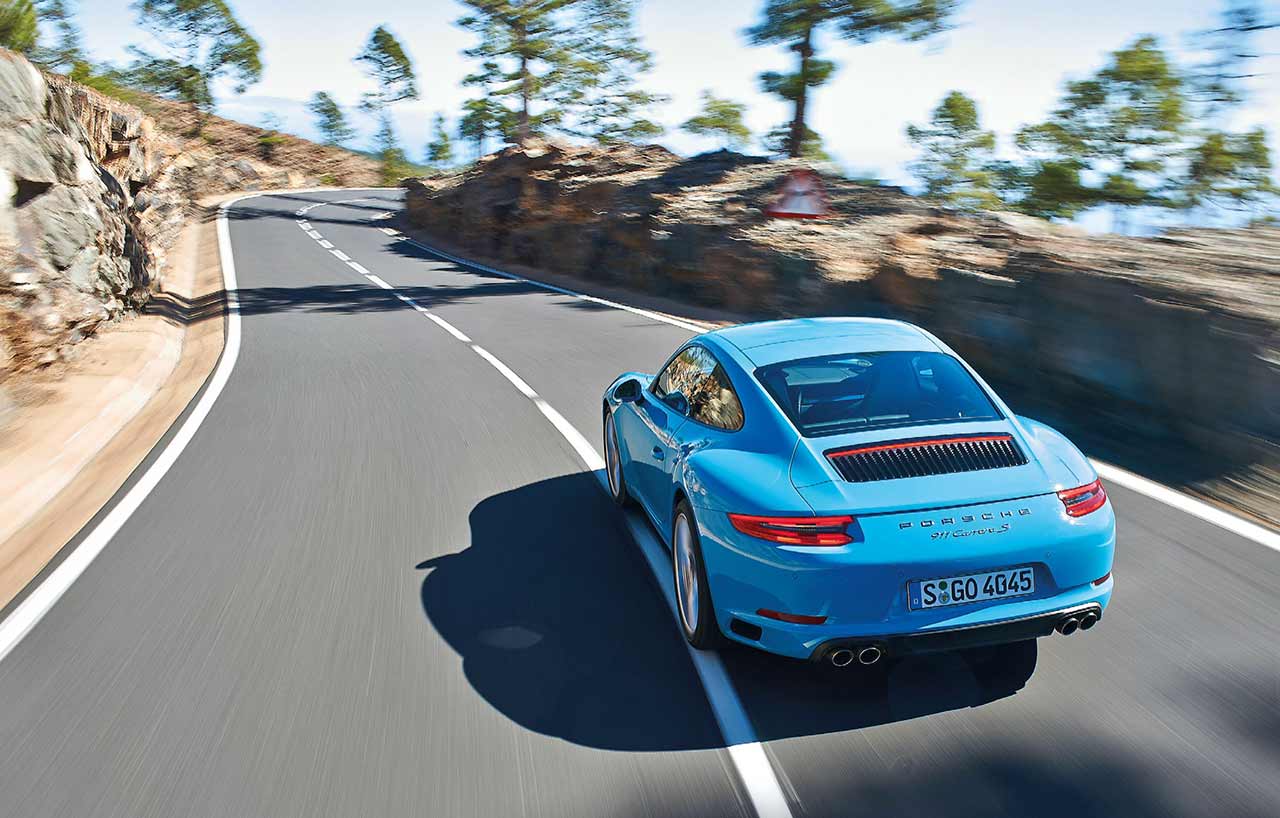
Porsche’s latest 911 Carrera 991.2 has sprouted turbos. Controversial? Certainly. Surprising? Perhaps not. The right move? We’re about to find out… Words by Henry Catchpole. Photography by Gus Gregory.
Blown away? DRIVEN: NEW 911 CARRERA S 991.2 Porsche has turbocharged the 911 Carrera. Is this the end of the world as we know it?
Forget about the turbocharged engine for a moment. It’s late in the afternoon and we’ve just landed in Tenerife, where the launch of this latest iteration of Porsche’s most famous car is being held. We’re following the prescribed route in the new Porsche Communication Management (PCM) system by driving up the dual carriageway towards the hotel. Sitting at 120km/h, sun visor down, shielding eyes from the setting glare, the new 360mm-diameter steering wheel is gently moving in my hands.

Having criticised, bemoaned and generally Disliked the lifeless electrically assisted steering of the first-generation 991-series 911, this constant stream of quiet but tangible chatter in the 991.2 is a very good thing. Admittedly, the first gen’s steering did improve gradually, but this feels like another step on to reducing the air of detachment. Sensing the road like this is akin to a conversation you can hear going on behind closed doors in another room. You don’t (for the moment) need to know the detail of what’s being said, but the tone of the happy voices is reassuring, letting you know that people are where they should be and all is well.
After a while the navigation leads us off the motorway, onto a long, curling slip-road and to a small roundabout. Neither of these is taken at more than four or possibly five on the tenths scale of driving intent, but again the car enters into a dialogue, this time dynamic. The weight shifts are subtle but the roll and pitch in the suspension is enough to let you know that this is a rear-engined car. Photographer Gus Gregory, sitting in the passenger seat, can feel it too. This is not a car trying to iron out all the individualities of its engine placement and that’s a very good thing.

We spot the right turn at the last moment and swing smartly off the main thoroughfare through a village. The lady in the dash politely asks us to make a U-turn but we respond by switching her off (as your hand approaches the new touchscreen, more options materialise like fish rising from the deep). We’re going to be late for dinner, but after a day in airports we’re making a bid for freedom, however fleeting, and heading for the glorious evening light and open roads of Tenerife’s volcanic uplands.
Despite the fact that Porsche probably thought Drive-My would like (or should have) a fully loaded car with such toppings as Porsche Dynamic Chassis Control (PDCC), carbon-ceramic brakes (PCCB) and the new-for-Carrera option of rear-wheel steering, we have in fact plumped for a very standard Carrera S. We’ll no doubt test all those add-ons in the coming months, but it seems only right to start at base camp rather than parachuting onto the summit. So, the 20-inch wheels are standard, the seven-speed manual gearbox is standard, our car has even got the normal S exhaust, with its two wide-set pairs of pipes rather than the two more centrally mounted cans of the Sports exhaust. Oh, and it’s Miami Blue – a stunning hue that partly looks like it needs a dash of orange and the word ‘Gulf’ and partly looks like it’s been pinched from a brochure for scuba diving in the Seychelles.
Tortured by the ravages of wildly fluctuating temperatures up at nearly 2000 metres, the dark black tarmac of the road around Mount Teide is so bumpy that even a neglected Australian back road could learn a thing or two from it. However, Porsche Active Suspension Management (PASM) is now standard on both Carrera and Carrera S and in the softer of its two settings it is coping well. ‘Soft’ perhaps isn’t quite the right adjective, because the Carrera S is firmly sprung; indeed spring rates have increased slightly over the old model to cope with the heavier engine. However, it isn’t uncomfortable and seems well judged for a sports car.
And what of the engine? Of the turbocharging there is certainly evidence, most obviously the pause then gentle exponential surge in acceleration when the throttle is deployed at low revs. Aurally it is accompanied by a relatively quiet shhhh, like a wave breaking on a shingle beach. The interesting thing is that a more naturally aspirated sound then takes over at about 5000rpm and instead of feeling all puffed out by the time the torque is dropping off, the revs keep rising and the sound keeps hardening until it crescendos at a rather lofty-feeling 7600rpm limiter. Peak power is 309kW at 6500rpm, compared with 294kW at 7400rpm in the old naturally aspirated S.
This is not an overtly boosty engine, like in a current McLaren or an F40 of old. There is no big explosion of hurricane-force fury. Rather it feels as though the turbocharging has been used more to torque-fill the lower reaches of the rev-range. As such, the Carrera S’s maximum of 500Nm arrives at a claimed 1700rpm (tome it feels a few hundred revs later, but it’s early nonetheless) and is sustained until 5000rpm. By comparison, the old naturally aspirated car didn’t reach its maximum of 440Nm until 5600rpm. A look at the graphs of the two torque ‘curves’ shows that the old engine lags between 150 and 120Nm behind the new engine all the way from2000 to 4000rpm.
The effects of this are several. Firstly it means you can now drive the 911 hard in two different ways. You can rely on the low-down torque, or you can rev it and use the power higher up. Whereas previously I would have felt obliged to go back-across-back for second gear when tackling this corner that we’re coming into, now I have a choice. With either second or third gear I know I am still going to be accelerating hard when I get back on the throttle. This means that I can work the rear axle much harder more of the time, which is crucial in a 911 because it is its prodigious traction out of corners (thanks to that weight distribution) that is arguably its most defining feature – particularly now there is so much turn-in grip from the front end.
This greater choice has another knock-on effect, namely that you can enjoy changing gear more of the time. With the first-generation 991, the stretch of road that we’re on would have been tackled solely using the first three of its rather tall gears, and realistically only two of those. Now at least one more gear has become an option and possibly two, because short-shifting isn’t a huge detriment to pace. You can surf along on ample waves of torque, enjoying snicking up and down the ’box, or you can hang on to gears and enjoy the full extent of the revs. Arguably, of course, what we would really like is a naturally aspirated engine with shorter gearing, but emissions legislation dictates otherwise.
If you’ve never been to Tenerife and purely consider it a rock crammed with package holiday sunloungers, then you really should reconsider. The views from the interior are some of the most amazing I have seen anywhere. When cool trade winds rise up as they reach the island, they hit the warmer air above and a bank of cloud forms at about 1000 metres, but never rises higher. We’re above the cloud now and it’s like we’re perched on a warm island in the middle of a white Arctic tundra. With Gus’s Nikon occasionally clicking and the cooling metal internals of the 911 gently pinking in sympathy, the sun slowly melts into the cloud, spreading orange across the horizon. Time to go and see if there’s any dinner left.
Saturday is spent with a Macan GTS in the morning and then getting photographs of the 911. It’s a good day, but by the end of it I feel there is still more to be learnt, so the stars are still out as I walk towards the car early on Sunday morning. Blipping the key summons up the 911’s own attempt at starlight as the bright white quad-LEDs in the headlights pierce the darkness. Dawn is still just far enough away that no wildlife is stirring yet and the distinctive metallic clank of a Porsche bootlid opening echoes loudly in the cold silence.
The flat-six comes to life in a slightly huffing, breathy way, settling to a more muffled version of the off-beat idle of generations past. We’ve got a good few hours to get some final impressions and do a spot of videoing (visit youtube.com for the results), so we’re heading back to the roads to the southwest of Teide. Climbing up through the cool predawn air, the flat-six seems happier than ever.
Curiously, at low-to-medium revs, under the relatively light initial loads that I’m subjecting it to, there is a soft featheriness to its burble that makes it sound almost like an old air-cooled 911. Strange, but quite comforting.
What I haven’t mentioned yet is just how blindingly fast this new 911 is. With a full PDK/Sport Plus setup it will crack 100km/h in just 3.9sec. According to the back of this magazine, that is as fast a Carrera GT. This car also laps the Nordschleife in 7min 30sec – four seconds quicker than a 997 GT2. That’s a 390kW, 680Nmcar with a nearly identical kerb weight, so it’s not all about the engine either; the mechanical grip that the new Carrera S can generate is astounding.
From my initial impressions I had thought the 991.2 would slide quite easily. The gentle sensations of roll suggested that if you pushed a bit further, the tyres would gently release and begin to smear across the asphalt. What actually happens is that as you push harder, so the Pirellis bite into the road surface, finding new reserves of tenacity. Particularly at the rear, just as you think a firm application of throttle must surely unstick the hold of the 305-sections, peeling the tread blocks from the road like a baddie lifting the fingers of a hero hanging to a cliff edge, so the axle suddenly seems to squat a little more and dig the outside tyre into the tarmac. This newfound purchase then fires you out of the corner like the proverbial cork out of the bottle. Sometimes you get little slides, but they’re the sort that hardly require any opposite lock, the car almost sliding to a neutral position as quickly as a corner opens out.
We have our chosen road almost entirely to ourselves this morning and there is along stretch of nearly a kilometer where I can see the Armco snaking up the rocky headland and nothing coming the other way. Driving a 911 or any of Porsche’s sports cars is generally satisfying on a basic level because of the weighting of all the controls and the 991.2 is thankfully no different. The seven-speed manual gearbox still isn’t quite as nice as the Cayman’s six-speed (it’s a touch lighter inaction), but the whole car feels responsive and mechanically connected. The feel underfoot of the middle pedal as you brake hard into corners, the reaction without any slack of the steering around the straight-ahead, the feel through the seat of your pants as the suspension deals with but doesn’t detach you from the road surface beneath: it all adds up to an involving and enjoyable driving experience.
It will be interesting to try the 991.2 on local roads and see how the steering feel stacks up over coarse-chip tarmac. But the crucial thing is that the new forced-induction engine hasn’t ruined the 911. The 3.0-litre flat-six seems to cleverly tread a delicate line, adding torque where it is needed but not giving a blatantly turbocharged delivery with a big kick that needs constant managing. The sound, although quieter, is better than we feared, too, and the Sports exhaust will no doubt help matters.
Purist it might not be, but at the end of the day, if turbocharging the Carrera like this means we can keep the naturally aspirated GT cars, then I’ll take it.
Less is more?
There is far less differentiation between the standard Carrera and the S in this second generation of 991. With no wider body on the S and essentially exactly the same 3.0-litre flat-six in the back of both, the main variation comes down to differing boost pressures of 0.9 and 1.1 bar respectively (thanks to larger Compressor wheels in the turbos of the S).
The end result is that the standard Carrera puts out 272kW at 6500rpm and 450Nm at 1700-5000rpm: 37kW and 50Nm less, but still good enough to propel it to 100km/h in just 4.2sec with a full PDK and Sport-Chrono setup or 4.6sec with the standard manual.
Dynamically, the Carrera now comes with PASM as standard, but it runs on smaller 19in wheels out of the box (although like the S’s 20s they are 8.5in wide at the front, 11.5in at the rear). The front brake discs a real so slightly smaller in diameter, measuring 330mm as opposed to 350mm on the S, while rear-wheel steering isn’t available on the base model.
We managed to grab a Carrera for a brief drive on the launch and it felt very good indeed. The S certainly has a bit more punch when the turbo comes on stream around 2000rpm, but the standard car is hardly lacking, accelerating with real urgency and a similar willingness up towards the redline. The car we tried had PDK, and the shits were Every bit as fast and crisp as we’ve come to expect, arguably bringing the performance completely into line with the manual S. The metal paddles are also things of rather sculptural beauty.
Although the drive was only short, the non-S did leave me wondering whether the Carrera (perhaps with a Sports exhaust) wouldn’t be all the 911 you actually need. It was certainly our feeling with the original 991. It also looks rather good value when you consider that the asking price of $208,200 is $36,600 below that of the S.
Tech and photos
TECHNICAL DATA FILE SPECIFICATIONS PORSCHE 911 CARRERA S MANUAL 7-SPD (991.2)
Engine 2981cc flat-six, dohc, 24v, twin-turbo
Max Power 309kW @ 6500rpm / DIN nett (metric)
Max Torque 500Nm @ 1700-5000rpm / DIN nett (metric)
Transmission Seven-speed manual, rear-wheel drive, LSD, PTV
Front suspension MacPherson struts, coil springs, adaptive dampers, anti-roll bar
Rear suspension Multi-link, coil springs, adaptive dampers, anti-roll bar
Brakes Ventilated discs, 350mm front, 330mm rear, ABS, EBD
Wheels 20 x 8.5-inch front, 20 x 11.5-inch rear
Tyres 245/35 ZR20 front, 305/30 ZR20 rear
Weight 1440kg
Power-to-weight 215kW/tonne
0-100km/h 4.3sec (claimed)
Top speed 307km/h (claimed)
Basic price $244,800
On sale Now
Drive-My rating 4.4
Right: slats on the rear are Now vertically arranged to improve airlow. Below: smaller steering wheel is inspired by the 918 Spyder’s; driving modes are selectable via a dial beneath the spokes.
The grip that the new Carrera S 991.2 can generate is astounding. This is not a car trying to iron out all the individualities of its engine placement.






